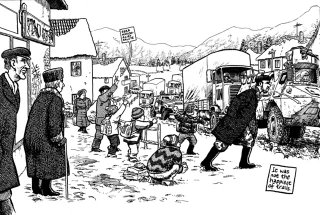FROM THE VAULT: Safe Area Gorazde
My daughter woke me up in the middle of the night yesterday, so I'm a very sleepy blogger today. Let's pulls something out from the archives then, this time a lengthy review of Joe Sacco's "Safe Area Gorazde" that ran all the way back in 2000.

In general, comic books are the last thing you think of when you hear the word journalism.
That's certainly not the case for Joe Sacco, however.
For some time, this extraordinary cartoonist has been on the frontlines of various international events, using comics to depict life in hot spots around the globe. From 1993-96, he created "Palestine," an outsider's look at relations between the Palestinians and Israelis that earned him an American Book Award.
Since then, he's turned his focus over to the conflict between Bosnia and Serbia, producing "Soba," the first of his several "Stories from Bosnia" and the wonderful short story "Christmas With Karadzic." Most recently, he has appeared in "Details" magazine, turning in a piece on Mississippi blues artist R.L. Burnside.
Now, Sacco has turned his eye back on Bosnia with "Safe Area Gorazde ," a 240-page epic that may very well be his best work yet.
For many Americans, the Balkan war that broke apart Yugoslavia inthe early 1990s must have seemed too far away, too horrible and too complicated to relate to.
There were too many warring sides committing atrocities in acountry that few knew anything about beyond its having hosted the Olympic games long ago.
In recent years, a number of books and articles have been published attempting to explain what went on between the Croats, Muslims and Serbs up to and beyond the Dayton peace accord, and many of them are excellent.
Few, to my mind, however, have had the emotional punch of "Safe Area Gorazde." Here, Sacco does more than attempt to explain the logistics of the war. He provides an intimate, terrifying portrait of what it's like to live under siege.
To some, the mere idea of conveying something as complex as a European war in comic form verges on being insulting if not laughable. Yet through the interplay of words and pictures, Sacco is able to create a sense of atmosphere that might otherwise be lost to the reader.
Whereas a photo or two might provide a quick if indelible image,Sacco is able to give us a sense of what Gorazde, the town he focuses his pen on, really looks like. We become familiar with its streets and bombed-out homes. As a result, we have an intimate feel for the town and its citizens that a novel or photo would struggle to provide.
For four months from 1995-96, -- right around the time of the Dayton accords -- Sacco toured what was once Yugoslavia, eventually focusing his eye on Gorazde, a Muslim enclave surrounded by Serb-controlled territory. Here was an area that had somehow survived the purges and massacres that "cleansed" other Muslim-dominated areas .
When asked by a student why he came to Gorazde, he replied, "Because you are still here, not raped and scattered, not entangled in the limbs of thousands of others at the bottom of a pit. Because Gorazde had lived and -- how?"
The book, then, becomes an examination of how the town, and by turnthe nation itself, disintegrated into violence, of how generation-old prejudices and suspicions turned neighbors against one another to the point where they were picking off one another with sniper rifles.
Virtually every aspect of life in Gorazde during the war is explored. Nothing goes unnoticed, whether it's the constant need for firewood, the handmade generators that provide little electricity or the dangerous late-night treks to a far-away army post for food supplies.
Because he didn't have stories that needed to be filed within 24 hours, Sacco had the time to tour the town and its people. The result is a work that delves into the common humanity of a besieged populace.
Perhaps what's most striking, apart from the grotesque brutality visited upon Gorazde 's citizens, is their almost desperate need to reattach themselves to the rest of the Western world. The people Sacco meets are eager to hear about Michael Jordan and "Pulp Fiction," to talk about anything except the war. Every girl he meets asks if he can get them 501 jeans (they must be "originals"). One local constantly belts out classic rock tunes and is eager to learn the lyrics to more in order to improve his English.
In the end, it is Sacco's art -- his incredibly detailed and realistic, yet cartoonish, panels -- that helps to draw the reader in to Gorazde 's plight. By the end, you feel as though you have been personally privy to this town's travails. His indelible images bridge the distance gap and create a strong empathetic connection. Gorazde 's citizens are not really so different from ourselves.
Certainly, this is not a book for the squeamish or for those whoare easily upset. Scenes of war, massacres and bloody operations may be enough to turn some eyes away.
But those with stronger stomachs will be sure to recognize this book for what the literary masterpiece it is. "Safe Area Gorazde" is a triumphant blend of art and writing and may redefined the way we look at comics and war reporting.
At the very least, it ought to make more people sit up and take notice of Joe Sacco.
Copyright The Patriot-News, 2000

0 Comments:
Post a Comment
<< Home